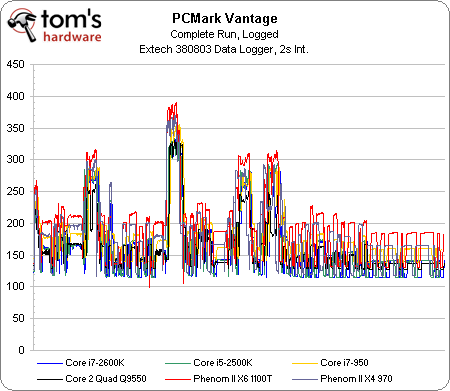Intel’s Second-Gen Core CPUs: The Sandy Bridge Review
Although the processing cores in Intel’s Sandy Bridge architecture are decidedly similar to Nehalem, the integration of on-die graphics and a ring bus improves performance for mainstream users. Intel’s Quick Sync is this design’s secret weapon, though.
Benchmark Results: Power Consumption
I’ve been having fun logging power in my graphics card reviews, so I’m going the same route here. I took data for all 10 configurations, but that turned out to be very messy on a single chart. So I left out the two lower-end Sandy Bridge chips, along with the Lynnfield and Clarkdale processors.
With six different series on the graph, there are some interesting observations to make. First, the Phenom II X6 1100T sucks down a lot of power, seemingly followed by the Phenom II X4 970.
In all actuality, when you run the averages, Intel’s Core i7-950 turns out to be the second most power-hungry processor (the X6 1100T winds up at 197 W, the i7-950 sits around 181 W, and the X4 970 averages 180).
| PCMark Vantage Complete Run | Core i7-2600K(Sandy Bridge) | Core i5-2500K(Sandy Bridge) | Core i7-950(Bloomfield) | Core 2 Quad Q9550(Yorkfield) | Phenom II X6 1100T(Thuban) | Phenom II X4 970(Deneb) |
|---|---|---|---|---|---|---|
| Average System Power | 163.99 W | 164.34 W | 181.73 W | 161.56 W | 197.12 W | 180.91 W |
How do Intel’s two fastest Sandy Bridge-based chips fare? The Core i7-2600K sits at 164 W. So does the Core i5-2500K. Compare those figures to the Core 2 Quad Q9550, which averages 161 W. Then go back and look at the PCMark Vantage results page. The Core i7-2600K pulls a first-place finish. The Core 2 Quad winds up last. Are these 32 nm chips more efficient (getting more work done within a similar power profile)? Yeah, we’d say so. We'll be following up in the next couple of days with a story dedicated to comparing Sandy Bridge's efficiency to a number of other platforms. More on that soon.
Get Tom's Hardware's best news and in-depth reviews, straight to your inbox.
Current page: Benchmark Results: Power Consumption
Prev Page Benchmark Results: Aliens Vs. Predator (DX11) Next Page Conclusion-
cangelini MoneyFace pEditor, page 10 has mistakes. Its LGA1155, not LGA1555.Reply
Fixed, thanks Money! -
juncture "an unlocked Sandy Bridge chip for $11 extra is actually pretty damn sexy."Reply
i think the author's saying he's a sexually active cyberphile -
fakie Contest is limited to residents of the USA (excluding Rhode Island) 18 years of age and older.Reply
Everytime there's a new contest, I see this line. =( -
englandr753 Great article guys. Glad to see you got your hands on those beauties. I look forward to you doing the same type of review with bulldozer. =DReply -
joytech22 Wow Intel owns when it came to converting video, beating out much faster dedicated solutions, which was strange but still awesome.Reply
I don't know how AMD's going to fare but i hope their new architecture will at least compete with these CPU's, because for a few years now AMD has been at least a generation worth of speed behind Intel.
Also Intel's IGP's are finally gaining some ground in the games department. -
cangelini fakieContest is limited to residents of the USA (excluding Rhode Island) 18 years of age and older.Everytime there's a new contest, I see this line. =(Reply
I really wish this weren't the case fakie--and I'm very sorry it is. We're unfortunately subject to the will of the finance folks and the government, who make it hard to give things away without significant tax ramifications. I know that's of little consolation, but that's the reason :(
Best,
Chris -
LuckyDucky7 "It’s the value-oriented buyers with processor budgets between $100 and $150 (where AMD offers some of its best deals) who get screwed."Reply
I believe that says it all. Sorry, Intel, your new architecture may be excellent, but unless the i3-2100 series outperforms anything AMD can offer at the same price range WHILE OVERCLOCKED, you will see none of my desktop dollars.
That is all.

